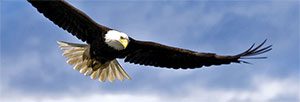After being rehabilitated at MSU, An orphaned bald eagle chick finds a permanent home at the Akron Zoo

Following a stormy Memorial Day weekend in 2011, veterinary researchers in northern Michigan heard peeping coming from a tree that had been uprooted by the wind. Upon investigation, they found a nest with two orphaned bald eagle chicks trapped inside. One was missing much of its right wing, and it was clear they’d been trapped for several days. On advice from veterinarians at a local animal rehabilitation facility, the researchers brought the eagles to the Veterinary Medical Center. They were treated by Dr. James Sikarskie, associate professor of zoo and wildlife medicine in the Department of Small Animal Clinical Sciences, and Dr. Justin Schlanser, resident.
After just a few days of regular feeding and care, the eagle with both wings intact was released into an eagle nest near where she had been found. The eagle with the broken wing had a much longer road to recovery. Schlanser, who also is an Army Ranger, named the eagle Petry after a fellow ranger who recently had been awarded a Congressional Medal of Honor for receiving a similar injury on duty.
When it comes to emergency and critical care in the hospital’s wildlife ward, “there’s a seasonal component to it,” Sikarskie says. In the winter he and his team see a higher number of animals hit by cars or poisoned from eating the carcasses of other animals killed with lead buck shot. In the spring, they see wild animals sick from eating fermented crab apples, as well as a higher number of orphaned animals, like the eagles.
During Petry’s operation, Sikarskie chose to preserve the injured wing, rather than perform a clean amputation of the wing above the joint. In doing so, Sikarskie also preserved Petry’s life, as federal regulations dictate that wild birds that require an amputation above the elbow be humanely euthanized.
Following the operation, the team used a honey-based ointment developed by Dr. Bryden Stanley in the Department of Small Animal Clinical Sciences. The ointment encourages granulation tissue to generate over the exposed bone, and is followed by a second ointment that encourages skin to grow. “It healed so well it grew feathers,” Sikarskie says.
Following Petry’s recovery, Sikarskie found a home for her at a nonprofit outdoor education organization in Holland, Michigan. However, during her transport, Petry injured her left wing. The incident landed her back at the VMC where, with her wing wrapped and healing, Sikarskie again began looking for a permanent home for Petry.
Enter Kim Cook, director of veterinary medicine at the Akron Zoo and a 2005 CVM graduate. During her time at Michigan State University, she was what Sikarskie fondly calls a “wardee,” a student who spends a lot of time working with Sikarskie and the animals in the wildlife ward. Around the same time the Akron Zoo was putting together a bald eagle exhibit, Cook heard through the U.S. Fish and Wildlife Office in her region that MSU had a non-releasable eagle.
“It was a match made in heaven—or in a Fish and Wildlife Service office in Minnesota, if you want to get technical,” Cook says.
The Akron Zoo’s bald eagle exhibit will be a featured part of its “Grizzly Ridge” native Ohio expansion, set to open in July 2013. The exhibit will house at least five non-releasable eagles, including Petry.
Until the exhibit is ready, Petry will spend time getting to know the other eagles in an off-exhibit area. “The introduction process between eagles is fairly easy,” Cook says,” so we don’t expect any problems with that.”
Though the Akron Zoo has been caring for bald eagles since the 1970s, Cook said the zoo keepers were particularly excited to meet Petry because of her reputation. “The [VMC] staff has been telling stories about what a neat bird she is.”
Posted: June 2013
Contact: Olivia Asiala
